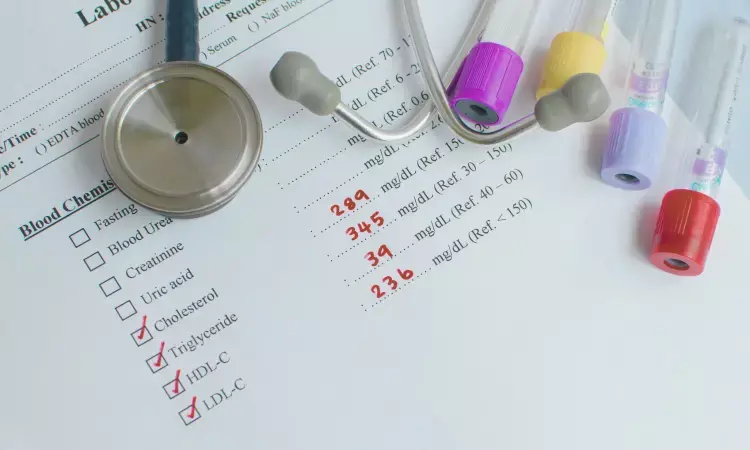- Home
- Medical news & Guidelines
- Anesthesiology
- Cardiology and CTVS
- Critical Care
- Dentistry
- Dermatology
- Diabetes and Endocrinology
- ENT
- Gastroenterology
- Medicine
- Nephrology
- Neurology
- Obstretics-Gynaecology
- Oncology
- Ophthalmology
- Orthopaedics
- Pediatrics-Neonatology
- Psychiatry
- Pulmonology
- Radiology
- Surgery
- Urology
- Laboratory Medicine
- Diet
- Nursing
- Paramedical
- Physiotherapy
- Health news
- Fact Check
- Bone Health Fact Check
- Brain Health Fact Check
- Cancer Related Fact Check
- Child Care Fact Check
- Dental and oral health fact check
- Diabetes and metabolic health fact check
- Diet and Nutrition Fact Check
- Eye and ENT Care Fact Check
- Fitness fact check
- Gut health fact check
- Heart health fact check
- Kidney health fact check
- Medical education fact check
- Men's health fact check
- Respiratory fact check
- Skin and hair care fact check
- Vaccine and Immunization fact check
- Women's health fact check
- AYUSH
- State News
- Andaman and Nicobar Islands
- Andhra Pradesh
- Arunachal Pradesh
- Assam
- Bihar
- Chandigarh
- Chattisgarh
- Dadra and Nagar Haveli
- Daman and Diu
- Delhi
- Goa
- Gujarat
- Haryana
- Himachal Pradesh
- Jammu & Kashmir
- Jharkhand
- Karnataka
- Kerala
- Ladakh
- Lakshadweep
- Madhya Pradesh
- Maharashtra
- Manipur
- Meghalaya
- Mizoram
- Nagaland
- Odisha
- Puducherry
- Punjab
- Rajasthan
- Sikkim
- Tamil Nadu
- Telangana
- Tripura
- Uttar Pradesh
- Uttrakhand
- West Bengal
- Medical Education
- Industry
Triglyceride to HDL cholesterol ratio strongly predicts diabetes development within 10 years

Japan: The ratio of triglycerides/HDL cholesterol is a stronger predictor of type 2 diabetes (T2D) development within ten years than triglyceride, HDL-C, or LDL-C, indicating its use in future medical treatment support, according to a recent study published in Cardiovascular Diabetology.
Previous studies have investigated the association between the ratio of triglycerides (TG) to high-density lipoprotein cholesterol (HDL-C) and diabetes incidence in adults and revealed that a high TG/HDL-C ratio was linked to an increased risk of new-onset diabetes. However, not much attention has been paid to the comparison of predicting the development of diabetes among lipid profiles, including the TG/HDL-C ratio, and the ratio of TG/HDL-C cut-off value.
To fill this knowledge gap, Hiroshi Okada, Department of Diabetes and Endocrinology, Matsushita Memorial Hospital, Moriguchi, Japan, and colleagues investigated the relationship between diabetes onset and the TG/HDL-C ratio in addition to the applicable cut-off value for predicting diabetes onset.
The study included 120,613 participants from the Panasonic Corporation's health examination database from 2008 to 2017. The association between lipid profiles, particularly the ratio of TG/HDL-C and T2D development was investigated using Cox regression analysis employing multivariable models.
The multivariable model was adjusted for sex, age, systolic blood pressure, BMI, smoking status, plasma glucose levels after fasting, and exercise habits. The prediction performance and cut-off values of each indicator were assessed by employing areas under time-dependent receiver operating characteristic (ROC) curves (AUCs). A self-reported history of diabetes, a fasting plasma glucose level of 126 mg/dL, or usage of antidiabetic medicines were used to identify type 2 diabetes.
Based on the study, the researchers reported the following findings:
- During the study, 6,080 people developed T2D. They were followed for a median of 6.0 years.
- Multivariable analysis revealed that the ratio of TG/HDL-C (per unit, HR; 1.03) was substantially linked to the risk of incident T2D.
- AUC and cut-off points for the ratio of TG/HDL-C for T2D development after 10 years were 0.679 and 2.1, respectively.
- The AUC of the ratio of TG/HDL-C was considerably larger compared to that of LDL-C, HDL-C, and TG alone.
- An interaction effect was discovered between BMI, sex, and lipid profiles in subgroup analysis.
- Females and participants having a BMI of < 25 kg/m2 showed a higher correlation between lipid profile levels and T2D onset.
"The findings demonstrate that the ratio of TG/HDL-C was a stronger predictor of type 2 diabetes development within 10 years than LDL-C, HDL-C, or TG," the researchers wrote. "These results indicated the importance of providing future medical care support."
Reference:
Yuge, H., Okada, H., Hamaguchi, M. et al. Triglycerides/HDL cholesterol ratio and type 2 diabetes incidence: Panasonic Cohort Study 10. Cardiovasc Diabetol 22, 308 (2023). https://doi.org/10.1186/s12933-023-02046-5
Dr Kamal Kant Kohli-MBBS, DTCD- a chest specialist with more than 30 years of practice and a flair for writing clinical articles, Dr Kamal Kant Kohli joined Medical Dialogues as a Chief Editor of Medical News. Besides writing articles, as an editor, he proofreads and verifies all the medical content published on Medical Dialogues including those coming from journals, studies,medical conferences,guidelines etc. Email: drkohli@medicaldialogues.in. Contact no. 011-43720751


